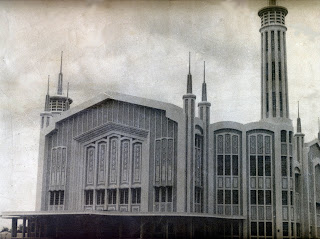 an. He was one of the six children of Melecio de Guzman Santos and Miguela Magpitang Antonio. His siblings were Miguela, Cezar, Adriana, Cleotilde, and Jorge.
an. He was one of the six children of Melecio de Guzman Santos and Miguela Magpitang Antonio. His siblings were Miguela, Cezar, Adriana, Cleotilde, and Jorge.Starting from San Miguel Elementary School, Carlos moved on to the Aten
 eo de Manila to finish his high school education in 1930. There he jo
eo de Manila to finish his high school education in 1930. There he jo ined the school band and was quite active in basketball. Throughout his life he continued on to play the saxophone and enjoyed the sport of lawn tennis. Further pursuing his dream to become a professional, he was one of the very first graduates of the College of Architecture of the University of Santo Tomas in the year 1935. During this time the professors then were outstanding architects and engineers of the period, such as Tomas Arguelles, Tomas Mapua, Juan F. Nakpil, Fernando Ocampo, and Andres Luna de San Pedro to name a few.
ined the school band and was quite active in basketball. Throughout his life he continued on to play the saxophone and enjoyed the sport of lawn tennis. Further pursuing his dream to become a professional, he was one of the very first graduates of the College of Architecture of the University of Santo Tomas in the year 1935. During this time the professors then were outstanding architects and engineers of the period, such as Tomas Arguelles, Tomas Mapua, Juan F. Nakpil, Fernando Ocampo, and Andres Luna de San Pedro to name a few.Upon gradu
 ating, he worked in the off
ating, he worked in the off ice of Juan Nakpil as a Draftsman, eventually rising to Associate Architect from 1946-1950. There he met J
ice of Juan Nakpil as a Draftsman, eventually rising to Associate Architect from 1946-1950. There he met J uan's youngest sister, Caridad, his future wife and mother to his children: Rosario, Milagros, Paz, Lourdes and Carlos Jr.
uan's youngest sister, Caridad, his future wife and mother to his children: Rosario, Milagros, Paz, Lourdes and Carlos Jr.Notably, Carlos passed and placed 10th in the board examination for architects in 1938. During this period he worked as an Assistant Architect for Wurdeman & Beckett, building the Jai-Alai court & gallery in Taft Avenue. Shortly after World War II, he decided to open his own office in partnership with Alfredo J. Luz. In 1955, both parted ways and practiced separately.
One of his most well known clients was the Christian evangelical group Iglesia ni Cristo (INC). Although his first exposure to t
 hem (through the San Juan Bishop's Palace) was executed under Juan Nakpil & Associate
hem (through the San Juan Bishop's Palace) was executed under Juan Nakpil & Associate , INC gave the second project (Cubao chapel or "kapilya") to Arch. Santos-Viola that initiated a long lasting work relationship building kapilyas all over the Philippines through excellent craftsmanship. His strict construction supervision of the INC's skilled workers greatly influenced the final outcome of his projects. The Master valued strict attention to detail that was emphasized prior to, during and after each every construction. His designs were primarily based on functionality that was built with integrity, adorned with 20th Century geometric forms garnished with Gothic and Baroque lines.
, INC gave the second project (Cubao chapel or "kapilya") to Arch. Santos-Viola that initiated a long lasting work relationship building kapilyas all over the Philippines through excellent craftsmanship. His strict construction supervision of the INC's skilled workers greatly influenced the final outcome of his projects. The Master valued strict attention to detail that was emphasized prior to, during and after each every construction. His designs were primarily based on functionality that was built with integrity, adorned with 20th Century geometric forms garnished with Gothic and Baroque lines. Arch. Santos-Viola was a devout Catholic throughout his entire life. He served as a Eucharistic Lay Minister for his parish, Our Lady of Lourdes Church. The INC never ceased persuading him to join their group through endless but friendly debates after their work meetings.
From 1949-1981, he shared his work experiences with the younger generation by teaching in his Alma Mater, the UST College of Architecture. His students loved him not only for the vast knowledge he imparted, but also on the paternal manner in assisting them to learn.
The Master was a proud pioneer member of the Philippine Institute of Architects since 1938. He actively participated in its activities in various capacities up to the Chancellorship position.
 Although his name was never inscribed in his masterpieces, Arch. Carlos A. Santos-Viola's legacy will stand tall throughout the Philippine Archipelago for decades to come.
Although his name was never inscribed in his masterpieces, Arch. Carlos A. Santos-Viola's legacy will stand tall throughout the Philippine Archipelago for decades to come.Text by Carlos "Boying" Santos-Viola


























